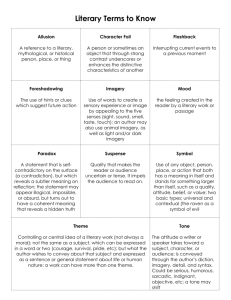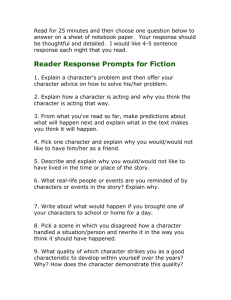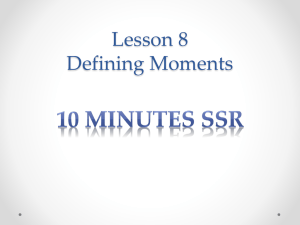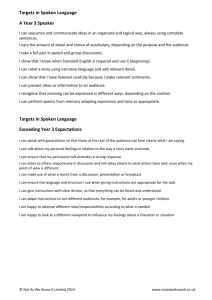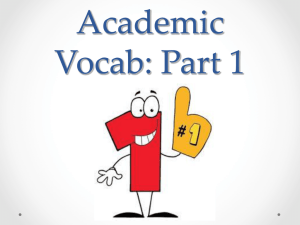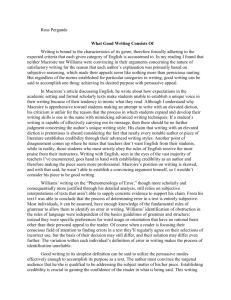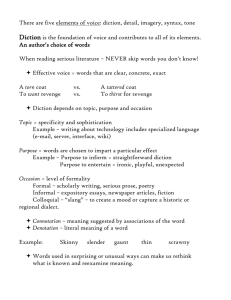CS--Unit 1--Literary Nonfiction
advertisement
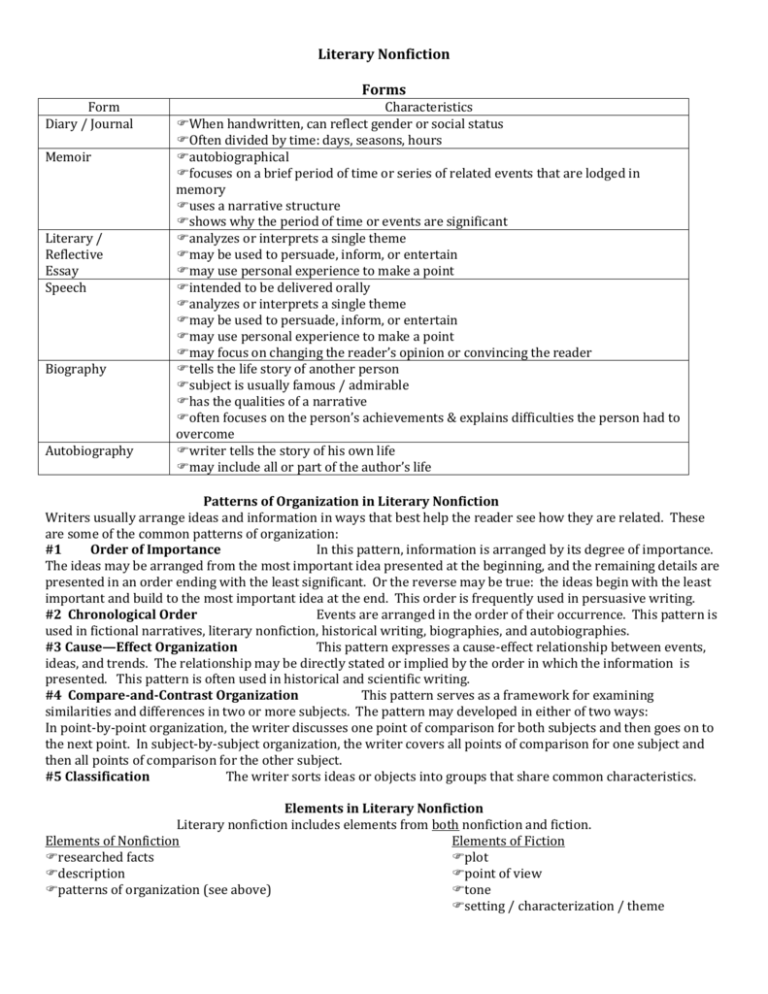
Literary Nonfiction Forms Form Diary / Journal Memoir Literary / Reflective Essay Speech Biography Autobiography Characteristics When handwritten, can reflect gender or social status Often divided by time: days, seasons, hours autobiographical focuses on a brief period of time or series of related events that are lodged in memory uses a narrative structure shows why the period of time or events are significant analyzes or interprets a single theme may be used to persuade, inform, or entertain may use personal experience to make a point intended to be delivered orally analyzes or interprets a single theme may be used to persuade, inform, or entertain may use personal experience to make a point may focus on changing the reader’s opinion or convincing the reader tells the life story of another person subject is usually famous / admirable has the qualities of a narrative often focuses on the person’s achievements & explains difficulties the person had to overcome writer tells the story of his own life may include all or part of the author’s life Patterns of Organization in Literary Nonfiction Writers usually arrange ideas and information in ways that best help the reader see how they are related. These are some of the common patterns of organization: #1 Order of Importance In this pattern, information is arranged by its degree of importance. The ideas may be arranged from the most important idea presented at the beginning, and the remaining details are presented in an order ending with the least significant. Or the reverse may be true: the ideas begin with the least important and build to the most important idea at the end. This order is frequently used in persuasive writing. #2 Chronological Order Events are arranged in the order of their occurrence. This pattern is used in fictional narratives, literary nonfiction, historical writing, biographies, and autobiographies. #3 Cause—Effect Organization This pattern expresses a cause-effect relationship between events, ideas, and trends. The relationship may be directly stated or implied by the order in which the information is presented. This pattern is often used in historical and scientific writing. #4 Compare-and-Contrast Organization This pattern serves as a framework for examining similarities and differences in two or more subjects. The pattern may developed in either of two ways: In point-by-point organization, the writer discusses one point of comparison for both subjects and then goes on to the next point. In subject-by-subject organization, the writer covers all points of comparison for one subject and then all points of comparison for the other subject. #5 Classification The writer sorts ideas or objects into groups that share common characteristics. Elements in Literary Nonfiction Literary nonfiction includes elements from both nonfiction and fiction. Elements of Nonfiction Elements of Fiction researched facts plot description point of view patterns of organization (see above) tone setting / characterization / theme DICTION, DETAIL, IMAGERY, SYNTAX, and TONE DICTION is the author’s choice of words. Diction shapes the reader’s perceptions and thoughts. The writer’s purpose partly determines diction. For example, if the author’s purpose is to inform, he will use straightforward diction, but is his purpose is to entertain, he will use words in ironic, playful, or unexpected ways. Diction can be formal or informal. EXAMPLE: Art is the antidote that can call us back from the edge of numbness, restoring the ability to feel for another. (Barbara Kingsolver, High Tide in Tucson) An antidote is something that counteracts a poison. By associating antidote with the restoration of ability to feel for another person, the author implies that the inability to feel for another is poison. Furthermore, this poison is so harmful that it takes us to the “edge of numbness.” DETAIL includes facts, observations, and incidents used to develop a subject. Specific details create a precise mental picture. Detail brings life and color to description, focusing the reader’s attention and bringing the reader into the scene. The author’s use of detail influences the reader’s views of the topic. EXAMPLE: The day has been hot and sultry. The sun has set behind great banks of clouds which are piling up on the northwestern horizon. Now that the light is beginning to fade, the great masses of cumulus, which are slowly gathering and rising higher toward the zenith, are lit up by pale flashes of sheet-lightning. (W.J. Holland, The Moth Book) The underlined details contribute to the reader’s mental picture of the clouds. These details—especially their order—imitate the building of the storm and capture the tension of the building storm, thus deepening the reader’s involvement. IMAGERY is the verbal representation of sensory experience. In literature all five senses may be represented: sight, sound, touch, taste, and smell. EXAMPLE: The rainy night had ushered in a misty morning—half frost, half drizzle—and temporary brooks crossed our path, gurgling from the highlands. (Emily Brontë, Wuthering Heights) Visual images include misty morning, half frost, half drizzle; a sound image is the word gurgling; rainy night and temporary brooks appeal to both sight and sound. Rain, mist, and frost are traditionally associated with feelings of sadness and depression, so the purpose of these images is to reinforce those feelings in the reader. SYNTAX refers to the way words are arranged within sentences. Syntax encompasses the following: word order—Departing from the usual word order (subject-verb-object/complement) can draw attention to the idea expressed in the sentence. sentence length—A short sentence following a longer sentence emphasizes the idea in the short sentence. Many modern writers put key ideas in short sentences. sentence focus—If the main idea is at the end of the sentence, the focus is on the main idea. If the main idea is at the beginning of the sentence, the focus is more on the ideas at the end of the sentence. repetition of a word, phrase, or clause emphasizes the repeated idea and focuses the reader’s attention. parallel structure—The author may construct words, phrases, or clauses in a similar way to show their equal importance or to connect ideas. EXAMPLE: While we do these things, these deeply momentous things, let us be very clear, and make very clear to all the world, what our motives and our objects are. (Woodrow Wilson, “President Woodrow Wilson Presents an Ideal to the War Congress”) In this sentence the subject and verb, which express the main idea, are delayed until the final part of the sentence. By placing the main idea in this position, the author stresses that “our motives and our objects” must be clear. TONE is the expression of attitude. It is the author’s (or narrator’s) implied attitude toward his subject. The writer creates tone by selection of words (diction), arrangement of words (syntax), and by purposeful use of details and images. The reader perceives tone by examining diction, detail, imagery, and syntax. EXAMPLE: And I started to play. It was so beautiful. I was so caught up in how lovely I looked that at first I didn’t worry how I would sound. So it was a surprise to me when I hit the first wrong note and I realized something didn’t sound quite right. And then I hit another and another followed that. A chill started at the top of my head and began to trickle down. Yet I couldn’t stop playing, as though my hands were bewitched. I kept thinking my fingers would adjust themselves back, like a train switching to the right track. I played this strange jumble through two repeats, the sour notes staying with me all the way to the end. (Amy Tan, The Joy Luck Club) The narrator’s attitude toward her performance begins with admiration and ends with horror. The diction in the first three sentences (beautiful, lovely, I didn’t worry) reveal her admiration of herself playing beautifully and looking lovely. Then the tone shifts, and the diction, detail, and imagery reflect the narrator’s growing horror as her performance goes terribly awry. First, she realizes something [doesn’t] sound quite right, and a chill started….and [trickled] down. Her hands feel bewitched as she plays this strange jumble, and the sour notes stay with her until the end.
